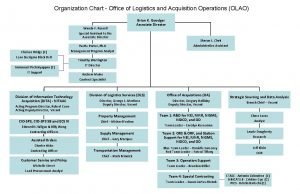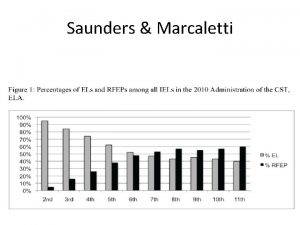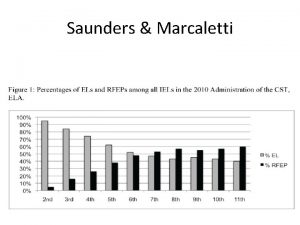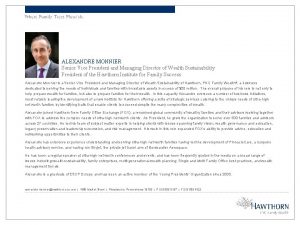Harlan Thompson is Managing Director and a Senior





























- Slides: 29

Harlan Thompson is Managing Director and a Senior Portfolio Manager at Bank of America Private Bank. In this role he is responsible for creating and managing personalized investment strategies for high net worth clients, family groups and private foundations. This includes assisting clients in defining their goals and objectives, developing an appropriate overall strategy, formulating and implementing potential solutions, and conducting regular portfolio reviews. In addition, he works with clients to navigate through changing market environments and provides traditional guidance in the areas of asset allocation, taxminimization strategies, retirement, and multi-generational strategies. Along with deep experience in the equity and fixed income markets, Harlan’s expertise includes alternative investments, private equity and tax aware equity strategies. Harlan Thompson, CFA® Managing Director Senior Portfolio Manager 213. 861. 5172 harlan. thompson@bofa. com 333 S HOPE ST LOS ANGELES, CA, 90071 Harlan has served as a senior portfolio manager for other investment management firms in the LA area, including Northern Trust, The Capital Group and Provident Investment Counsel. At one time, Harlan held the position of West Coast Chief Investment Officer for US Trust. He recently rejoined the firm. His 30+ year career in the financial services industry began at Wedbush Securities and has recently served on their Board of Directors. Harlan received his B. S. degree in Industrial Engineering from Oregon State University and his M. B. A from the University of Southern California. In addition, he holds the Chartered Financial Analyst® (CFA®) designation and is a member of the CFA® Institute and the CFA® Society of Los Angeles. *Some or all alternative investments may not be suitable for certain investors. Certain alternative investments carry significant risk and are not subject to the same regulatory oversight as mutual funds and other traditional investments. For these reasons, access to alternative investments may be limited to investors who are designated as sophisticated, high-net-worth investors. Bank of America. Private Bank is adivision of Bank of America, N. A. , Member FDICandawholly ownedsubsidiary of Bank of America Corporation(“Bof. A Corp. ”). Banking products are providedby. Bank of America, N. A. , andaffiliated banks, Members FDIC, andwholly ownedsubsidiaries of Bof. A Corp. Investment products: Are Not FDIC Insured Are Not Bank Guaranteed May Lose Value CFA®and. Chartered Financial Analyst®are registered trademarksof the CFAInstitute. © 2019 Bank of America Corporation. All rights reserved. | ARTSLGXDVault-BA 13 Z 9 | PB-204 -KIT Tolearn about Bankof America’senvironmental goalsandinitiatives, goto bankofamerica. com/environment. Leaf icon is aregistered trademarkof Bank of America Corporation.

Thematic Investing - A Transforming World The world is undergoing profound macro changes. Against this backdrop and amid times of market volatility and uncertainty, it is beneficial for investors to reset and think longer-term. Below details the forces behind the 10 Themes for the Next 10 Years from Bof. A Global Research’s Transforming World framework: Peak Globalization The end of unrestricted free movement of labor, goods, and capital around the world. Beneficiaries: Local Markets, Real Assets Areas at Risk: Global Markets Recession Record number of Fund Manager Survey investors think the global economy is late-cycle, the bond market bubble is set to unwind and populism is likely to be inflationary. Beneficiaries: Inflation, Real Assets, Infrastructure Areas at Risk: Growth, Credit, Deflation Quantitative Failure Monetary policy measures are proving less and less effective at boosting corporate and household “animal spirits”. Beneficiaries: Keynesianism, Gold Areas at Risk: Financial Assets, Monetarism Demographics The number of grandparents will outnumber the world’s children; every second, five people enter the emerging market middle class and Gen Z overtakes Millennials. Beneficiaries: e. Commerce, New Consumer Areas at Risk: Bricks & Mortar, Legacy Consumer Climate Change Investors are more focused than ever on global warming’s impact on the economy, society, unemployment and migration. Beneficiaries: Clean Energy, Electric Cars Areas at Risk: Fossil Fuels, Diesel Cars, Single-Use Plastics Robotics & Automation Up to 50% of jobs are at risk of automation by 2035. Beneficiaries: Automation, Local Production, Big Data & Artificial Intelligence Areas at Risk: Humans, Global Supply Chains Splinternet* China to overtake the U. S. and become the world leader in AI by 2030. ‘Sovereign internets’ expand. Beneficiaries: Emerging Markets/The East Areas at Risk: Developed Markets/The West Moral Capitalism $20 trillion is going into environmental, social and governance (ESG) strategies over the next 20 years, nearly equal to the market cap of the S&P 500. Beneficiaries: ESG, Impact Investing, Stakeholders Areas at Risk: Business-As-Usual Investing, Solely Profit-Maximizing Firms Smart Everything 500 billion connectable devices by 2030 to combat deflationary demographics but at the risk of the death of privacy. Beneficiaries: Internet of Things, Connectivity, Smart Cities, ‘Big Brother Tech’ Areas at Risk: Privacy, Offline Space Tourism and nanosatellites are the next frontier for an industry that could be worth $1 trillion by 2030. Beneficiaries: Aerospace & Defense Areas at Risk: Legacy Satellites *Bof. A Global Research uses the term Splinternet when covering the global race for technological supremacy and ‘sovereign internets. ’ Source: Bof. A Global Research as of November 11, 2019. 62 of 86 Q 4 2019 - Chart Book

Economic Outlook Macro economic outlook from the Chief Investment Office. UNITED STATES • Activity in the housing sector has picked up, which along with the strong consumer spending should help to support economic growth in the U. S. as global growth stabilizes. EMPLOYMENT, INFLATION & INTEREST RATES • Inflation pressures remain muted since peaking the summer of 2018. • Federal Reserve (Fed) interest rate hikes are unlikely in 2020, in our view. • Consumer confidence is strong helping to support the U. S. economy. • Pro-business U. S. fiscal and regulatory policies, combined with low inflation suggest more accommodative monetary policy can fuel a positive, self-reinforcing growth dynamic, WATCH LIST boosting profits and potentially extending the DOLLAR & COMMODITIES economic cycle. We believe this is a positive U. S. Inflation backdrop for equities. • Relatively easier U. S. monetary policy and an eventual pickup U. S. Election in growth abroad should put downward pressure on the Earnings dollar. China and Trade Policies • We believe that oil prices will continue to fluctuate in the Central Bank Meetings GLOBAL $50 to $70 per barrel range for the foreseeable future. A Brexit Terms softer dollar would support oil prices at the top of the range. U. S. Trade Policy • The Coronavirus outbreak has imparted a big deflationary shock to the global economy that may temporarily depress world Gross Domestic PROFITS Product (GDP) and inflation. Despite this setback, • We expect U. S. corporate profits to grow mid- to single-digits in trade and Brexit headwinds have eased, and the U. S. economy is 2020 with revenue increases from a strong consumer base healthy, led by the consumer. Overall global growth is stabilizing offsetting a slowly improving business sector. An eventual with both domestic and international commerce set to improve pickup in global growth would be an additional tailwind in 2020. Source: GWIM Investment Strategy Committee (GWIM ISC) as of February 5, 2020. 2940758 Please refer to other important information at the end of this presentation. CIO views are subject to change. Past performance is no guarantee of future results. 13 of 86 Q 4 2019 - Chart Book

CORONAVIRUS Exhibit 2: Cases (deaths) Economic impact Markets During* Markets After (3 months**) Severe Acute Respiratory Syndrome (SARS) Late 2002 -2003 17 countries, mostly Southeast Asia 8, 098 (774) Greater effect in China— weaker consumer spending and growth but bounce back in subsequent quarters. S&P 500: -14% 10 Yr TSY: -68 bps WTI Crude: 48% VIX: 50% S&P 500: 24% 10 Yr TSY: -42 bps WTI Crude: -17% VIX: -39% Middle East Respiratory Syndrome (MERS) South Korea outbreak May-July 2015 27 countries, mainly Arabian Peninsula and South Korea 2, 494 (858) globally 186 (36), South Korea GDP decline of 0. 5% in 2 Q 2015, 26% decline in retail sales from S&P 500: -4% 10 Yr TSY: -36 bps WTI Crude: -23% VIX: 67% S&P 500: -2% 10 Yr Tsy: -9 bps WTI Crude: -2% VIX: -11% Ebola Virus Disease (EVR) Mid-late 2014 10 countries, mainly West Africa 28, 652 (11, 325) Negligible affects to U. S. growth S&P 500: -7% 10 Yr TSY: -48 bps WTI Crude: -22% VIX: 139% S&P 500: 7%% 10 Yr TSY: -42 bps WTI Crude: -43% VIX: -15% Wuhan coronavirus Late 2019 - present 21 countries, mostly Southeast Asia 9, 776 (213) 2020 China GDP expectations downgraded from 5. 8% to 5. 6% May through July, central bank rate cut of 25 bps S&P 500: -3% TBD 10 Yr TSY: -35 bps WTI Crude: -19% VIX: 58% Sources: Chief Investment Office, Center for Disease Control; World Health Organization; Johns Hopkins. CSSE; Statistics Korea, Bof. A Global. Research. Dataasof January 31, 2020*From peak-to-trough within timeframe of outbreak ** Fromequity trough

Chart 2: Companies with high China exposure saw bigger estimate cuts, but analysts still expected the impact to be transitory Chart 1: Analysts have cut their 1 Q EPS estimates by 2. 6% since the coronavirus outbreak, but 2 Q-4 Q estimates were largely unchanged Top 25 companies by. China exposurebottom-up cons. EPS trend (1/1/20 -2/25/20) S&P 500 bottom-up 1 Q 20 and 2 Q-4 Q 20 consensus. EPS trend(1/1/20 -2/25/20) 10 1 10 0 99 98 97 96 95 94 93 92 91 1/1 90 10 0 9 9 9 8 Wuhan quarantin ed 9 7 9 6 1/1 1/8 1/15 1/22 1/29 1 Q 20 4 Q 20 2/5 2 Q- 2/1 2 2/1 9 S&P 500 pricereturn decompositionsince January 23 5 % 0% 5% Chg in Fwd EPS Chg in Fwd P/E Price change Energy als Industri Care Health s Financial ls Materia Svcs. h Comm. Tec S&P 500 Disc. Cons. Staples s Utilitie 10% Real Estate 1/22 1 Q 20 4 Q 20 1/29 2/5 2 Q- 2/1 2 2/1 9 Market increasingly pricing in the risks The entire selloff so far since Jan. 23 (when Wuhan was quarantined) has been driven by P/E compression (-6%), as fwd. EPS is largely unchanged. Chart 3: The sell-off has been entirely driven by multiple compression Source: Fact. Set, Bof. A US Equity & Quant Strategy 1/8 1/15 Source: Bof. A US Equity & Quant Strategy, Fact. Set 15% Wuhan quarantin ed

U. S. TREASURY YIELD CURVE February 02, 2020 4. 0 3. 5 2/2/2020 6 months ago Yield (%) 3. 0 2. 5 2. 0 1. 5 1. 0 Source: U. S. Treasury Bills; Fact. Set Data Systems. Used with permission. Data as of February 02, 2020. Past performance is no guarantee of future results. ARJW 8 XXY 1 year ago

U. S. TREASURY YIELD CURVE March 01, 2020 4. 0 3. 5 Yield (%) 3. 0 2. 5 2. 0 1. 5 1. 0 Source: U. S. Treasury Bills; Fact. Set Data Systems. Used with permission. Data as of March 01, 2020. Past performance is no guarantee of futureresults. ARJW 8 XXY 3/1/2020 6 months ago 1 year ago

Accommodative Fed Policy Supporting the Expansion The 180 -degree pivot by the Fed from “overly tight”, to “too patient”, to “more accommodative” has helped to uninvert the yield curve and support the economic expansion in the U. S. The Fed joins a chorus of other global central banks who have stepped in to ease policy in response to downward pressure on economic growth. The yield curve un-inverted once the Fed stopped running off its balance sheet… 4. 7 Percent (%) 2. 00 1. 75 1. 50 Sep-19 Jun-19 Mar-19 Dec-18 Sep-18 Jun-18 Mar-18 Dec-17 Sep-17 Jun-17 1. 25 Mar-17 Sep-17 Trillions of U. S. Dollars 3. 7 Fed’s 2% Target 2. 25 Sep-19 -0. 5 Jun-19 3. 9 Mar-19 0. 0 Dec-18 4. 1 Sep-18 0. 5 Jun-18 4. 3 Mar-18 1. 0 Dec-17 4. 5 Jun-17 1. 5 Mar-17 Percent (%) 5 -Year Inflation Expectations 3 Month/10 Year Yield Curve (LHS) Fed Balance Sheet (RHS) 2. 0 …inflation expectations are still low, suggesting the Fed is unlikely to raise rates anytime soon. Global monetary easing remains in high gear. Fed Funds Rate (LHS) Average Policy Rate: Advanced Economies [ex US, LHS] Average Policy Rate: Emerging Markets (RHS) Percent (%) 2. 5 7. 0 6. 5 2. 0 6. 0 1. 5 5. 5 1. 0 5. 0 0. 5 4. 5 Percent (%) 3. 0 In response to signs of slower global economic growth, a number of central banks such as the Fed and the ECB, along with central banks in India, Brazil and Russia have stepped in to cut interest rates. Others like the Bank of Japan and People’s Bank of China have eased policy or maintained their accommodative stances as well. 4. 0 0. 0 2011 2012 2013 2014 2015 2016 2017 2018 2019 Sources: (Top Left and Right) Bloomberg. Data as of December 31, 2019. (Bottom) Federal Reserve Bank of Dallas; Haver Analytics. Data as of December 31, 2019. 16 of 86 Q 4 2019 - Chart Book

(E) Earnings & Economic Growth If the outlook for global trade and manufacturing improves that will help buoy economic growth and earnings globally, but for China, Europe and Japan relatively more given that the sector composition of international stocks is more skewed towards cyclicals than defensives compared to the United States. A more pronounced shift in positioning to go along with stronger economic growth outside the U. S. and an improvement in manufacturing and trade activity could support international equity performance over the near term. Global earnings growth has slowed substantially in 2019 but is poised to accelerate going forward, in our view. S&P 500 Japan Europe Emerging Markets -5% Real GDP Growth (Yo. Y, %) 9% 5% 8% 15% 0% -13% -11% 5% 5% 3% 15% 22% 19% 25% 11% 17% 29% Earnings Growth (Yo. Y, %) 35% -15% -25% 2017 2018 2019 E 2020 E In recent months we’ve also seen trends in earnings revision ratios begin to favor non-U. S. equities, especially in Japan and Emerging Markets, suggesting that the outlook for corporate earnings outside the U. S. could be starting to improve. Note: Non-U. S. data represent the respective MSCI Indexes. Sources: (Left) Fact. Set Consensus Estimates. Data as of December 31, 2019. (Right) Haver Analytics. Data as of December 31, 2019. 23 of 86 Q 4 2019 - Chart Book

(T) Trade Tensions and (E) Election Concerns The U. S. –China trade war was escalating for much of 2019 as tariffs were raised and restrictions were placed on key areas. Ultimately, talks broke down until the realization began to take hold that economic growth was deteriorating globally. And as it relates to this year’s Presidential Elections, political risk should be high but we expect equity markets to potentially benefit from a de-risking in the near term as investors take their cue from the other elements of the METERS equation. A “trade truce” may help to reduce uncertainty and boost consumer and business sentiment, global trade activity, and manufacturing. Politics could come into play as the 2020 U. S. Presidential Election approaches. Total U. S. -China Goods Trade (Exports + Imports) Year-over-Year Change (%) 40% 30% 20% 10% 0% -10% 2010 2011 2012 2013 -20% 2014 2015 2016 2017 2018 2019 Sources: (Left) BEA. Data as of December 31, 2019. (Right) Strategas Research Partners. Data as of December 31, 2019. 24 of 86 Q 4 2019 - Chart Book

Despite Headline Risks, Markets Have Climbed the Wall of Worry S&P 500 Index U. S. equities have been able to overcome the noise in 2019 and we expect another leg up in equities in Q 1 2020 with the non-U. S. markets participating more in line with the United States. A new cyclical upswing is already underway, in our view, supported by accommodative monetary policy and a bottoming in overseas economic growth sooner rather than later. Sources: Chief Investment Office; Media Reports. Data as of December 31, 2019. 35 of 86 Q 4 2019 - Chart Book

Unlike 2019, Earnings Should Be the Driver in 2020, In Our View As we look ahead to 2020, we expect earnings to trough soon and accelerate throughout the year as economic growth in the U. S. and globally start to stabilize. We think there is limited scope for multiple re-rating given the upcoming presidential elections creating an uncertain outlook for corporate taxes, as well as the potential regulation of several sectors. On the flip side, rising central bank liquidity, low interest rates and nascent positive fund flows for equities may enable a nudge higher for multiples, supporting our case for a grinding, choppy equity uptrend. Our expectation of an improved outlook for corporate earnings along with reasonable valuations support our relative preference for equities over fixed income. Change in 2020 Earnings Estimates Since December 2018 S&P 500 Europe 2% Japan Emerging Markets S&P 500 35% Emerging Markets Europe Japan 30% Non-U. S. data represent the respective MSCI Indexes. Sources: Fact. Set; Chief Investment Office. Data as of December 31, 2019. Past performance is no guarantee of future results. The economic and market forecasts presented are for informational purposes as of the date of this report. There can be no assurance that the forecasts will be achieved. There is no guarantee that this trend will continue. Please refer to appendix for asset class proxies and index definitions. Indexes are unmanaged and do not take into account fees or expenses. It is not possible to invest directly in an index. 37 of 86 Q 4 2019 - Chart Book Dec-2019 Nov-2019 Oct-2019 Sep-2019 Aug-2019 Jul-2019 May-2019 -5% Apr-2019 -18% Mar-2019 0% Jan-2019 -16% Jul-2019 5% Jun-2019 -14% 10% May-2019 -12% 15% Apr-2019 -10% Mar-2019 -8% 20% Feb-2019 -6% 25% Jan-2019 -4% Dec-2018 Change in P/E Multiples (%) -2% Dec-2018 Change in Consensus Estimates (%) 0% Multiple Expansion Did Most of the Heavy Lifting in 2019

Equity Market Update: The Decades in Review Equity markets closed out the 2010 s by reaching new all-time highs as worries over recession, trade wars and Brexit all slowly began to fade. Coming out of the worst financial crisis since the Great Depression, the bull market has rumbled on throughout this past decade despite a litany of obstacles like the Euro Zone debt crisis, Chinese economic slowdown, oil price collapse and government shutdowns, just to name a few. S&P 500 Total Returns: 1928 – 2019 (Annual, %) S&P 500 By Decade Annual Return (incl. Dividends) Number of Record Highs Number of Corrections 1950 s 13. 6% 19. 3% 141 6 1960 s 4. 4% 7. 8% 224 5 1970 s 1. 6% 5. 9% 35 7 1980 s 12. 6% 17. 5% 190 9 1990 s 15. 3% 18. 2% 310 5 2000 s -2. 7% -0. 9% 13 11 2010 s 11. 2% 13. 5% 242 6 Sources: (Left) LPL Research; Bloomberg. (Right) Bloomberg. Data as of December 31, 2019. Results shown are based on an index and are illustrative; they assume reinvestment of income and no transaction costs or taxes. Indexes are unmanaged and do not take into account fees or expenses. It is not possible to invest directly in an index. Past performance is no guarantee of future results. Please refer to appendix for asset class appendix and index definitions. 26 of 86 Q 4 2019 - Chart Book



Economic and Market Forecasts Q 2 2019 A Q 3 2019 A Q 4 2019 A Q 1 2020 E Real global GDP (% y/y annualized) - - - 2. 9 - 3. 1 Real U. S. GDP (% q/q annualized) 2 2. 1 2. 3 1 1. 7 CPI inflation (% y/y) 1. 8 2. 3 Core CPI inflation (% y/y) 2. 1 2. 3 2. 2 2. 3 2. 4 Unemployment rate(%) 3. 6 3. 5 3. 7 3. 5 Fed funds rate, end period (%) 2. 4 1. 9 1. 55 1. 63 10 -year Treasury, end period (%) 2. 01 1. 66 1. 92 1. 8 S&P 500 end period 2942 2977 3231 - 3300 41 42 41. 5* 164. 1* 40. 5 177 Euro/U. S. dollar, end period 1. 14 1. 09 1. 12 1. 15 U. S. dollar/Japanese yen, end period 108 109 110 103 Oil ($/barrel, avg. of period, WTI**) 60 56 57 57 59 57 S&P earnings ($/share) The forecasts in the table above are the base line view from Bof. A Global Research team. The Global Wealth & Investment Management (GWIM) Investment Strategy Committee (ISC) may make adjustments to this view over the course of the year and can express upside/downside to these forecasts. A=Actual. E/*=Estimate. ** WTI: West Texas Intermediate. S&P 500 represents a fair value estimate for 2020. Sources: Bof. A Global Research; GWIM ISC as of January 31, 2020. Bof. A Global Research is research produced by Bof. A Securities, Inc. (“Bof. AS”) and/or one or more of its affiliates. Bof. AS is a registered broker-dealer, Member SIPC, and wholly owned subsidiary of Bank of America Corporation. Past performance is no guarantee of future results. The economic and market forecasts presented are for informational purposes as of the date of this report. There can be no assurance that the forecasts will be achieved. There is no guarantee that this trend will continue. Please refer to appendix for asset class disclosures and index definitions. 69 of 86 Q 4 2019 - Chart Book

U. S. Business Cycle Indicator Dashboard The CIO tracks various metrics (below), which currently indicate that the U. S. economy remains on an expansionary course. However, we are watching inflation, the yield curve, and several other data points for any shift towards a recessionary trend. Business Cycle Dashboard Expansionary, but in extended territory Expansionary Inflation Price inflation, wage inflation January 2020 Inflation Labor Market Jobs created, Unemployment claims, avg. weekly hours, wage inflation Labor Market Yield Curve Yield curve (10 yr-Fed Funds) Neutral Current readings of Business Cycle Indicators U. S. Business Consumer Conditions Consumer confidence ISM* manufacturing, capacity utilization, small bus. optimism Recessionary Housing Market Credit Conditions Equity Market Housing starts, new building permits Corporate debt spread, bank lending Profit margins, equity valuation (P/E) Credit Conditions Equity Market Historical Business Cycle Indicators at the Beginning of Recession Yield U. S. Business Housing Curve Consumer Conditions Market December 2007 March 2001 *ISM= Institute for Supply Management. Indicator is in extended territory if majority of data tracked in that category is outside the bounds of what we consider to be moderate levels. Sources: Bloomberg; Haver Analytics; Federal Reserve Bank of St. Louis; Chief Investment Office. Data as of January 13, 2020. Past performance is no guarantee of future results. The economic and market forecasts presented are for informational purposes as of the date of this report. There can be no assurance that the forecasts will be achieved. There is no guarantee that this trend will continue. Please refer to appendix for asset class proxies and index definitions. 14 of 86 Q 4 2019 - Chart Book

Global Growth Upturn Beginning to Take Shape For much of the past 18 months we have experienced some major headwinds to global growth (tight Federal Reserve policy, a strong Dollar, a struggling European and Chinese economy, and the trade war). Most, if not all, of these are turning to small tailwinds, in our view. Early evidence suggests that a fourth mini-cycle is beginning to take shape. Global Central Banks are back in easing mode to support global growth. Year-over-Year Change (%) in Balance Sheet Assets (Trillions of U. S. $) Global Manufacturing PMI (LHS) OECD*+Major 6 Non-Members: Leading Indicator (RHS, Pulled Forward 6 Months) 5. 0 55 54 2. 5 3. 5 51 3. 0 50 2. 5 49 48 2. 0 2012 2013 2014 2015 2016 2017 2018 2019 2020 Year-over-Year Change (%) 52 Year-over-Year Change (%) 4. 0 Federal Reserve Bank of Japan European Central Bank Total 2. 0 4. 5 53 Index Level 3. 0 1. 5 1. 0 0. 5 0. 0 -0. 5 -1. 0 2007 2008 2009 2010 2011 2012 2013 2014 2015 2016 2017 2018 2019 *OECD (Organization for Economic Cooperation and Development). The 6 non-members included are as follows: Brazil, China, India, Indonesia, Russia, South Africa. Source: Haver Analytics. Data as of January 1, 2020. Past performance is no guarantee of future results. Please refer to appendix for asset class disclosures and index definitions. Indexes are unmanaged and do not take into account fees or expenses. It is not possible to invest directly in an index. 15 of 86 Q 4 2019 - Chart Book

INFLATION EXPECTATIONS Exhibit 1: Real GDP Growth Has Increasingly Lagged Potential Growth, Pointing to a Peak in “Core” Inflation in Coming Quarters. Potential. Growth. Gap(real. GDPgrowthminuspotential. GDPgrowthproxy*, Left. Scale) Consumer. Price. Indexfor. All. Urban. Consumers(CPI-U): All. Items. Less. Foodand. Energy(y/y% change, Right. Scale) 3% 0% -3% -6% -9% 2001 -Q 1 2004 -Q 1 2007 -Q 1 2010 -Q 1 *Sum of laborforce growth andproductivity growth. Sources: Haver Analytics; Chief Investment Office. Dataasof February 12, 2020. 2013 -Q 1 2016 -Q 1 2019 -Q 1

What Contributes to Long-Term Equity Appreciation? In the long-term, the total return composition of the S&P 500 Index tends to be driven by earnings and dividend growth, but in the short term, other factors such as geopolitics, monetary policy uncertainty, and political tensions (among others) can impact investor sentiment and result in markets generating returns vastly differing from historic norms. S&P 500 Total Return Composition EPS Growth 25% 20% FWD P/E Ratio 18. 3 x 18. 5 x 15. 8 x 14. 5 x 15% 10% Dividend Yield 10. 0% 11. 5% 5% 31. 5% 0% (4. 4%) -5% Long Term Average 2018 2019 2020 E *Note: Italicized figure indicates full-year total return. E= Estimate Source: Chief Investment Office. Data as of December 31, 2019. EPS Growth data from Bof. A Global Research since 1926. Dividend Growth data from Bloomberg since 1970. Total Return data from Bloomberg since 1988. Forward Twelve Months Price-to-Earnings data from Bloomberg since 1990. FWD/PE Ratio indicates year-end figure, with the exception of the long-term average. Past performance is no guarantee of future results. Please refer to appendix for asset class proxies, glossary and index definitions. 36 of 86 Q 4 2019 - Chart Book

2020 Year Ahead: The Bull Trots On Through A World In Transition In addition to our more balanced view and accompanied portfolio strategy we expect two other scenarios to be debated throughout most of 2020. 1) a melt-up scenario that benefits risk assets significantly The three scenarios in total include: 2) a balanced view (our base case) that mixes growth optimism with election uncertainty over the summer 3) a negative performance scenario in which growth falters and geopolitical risks rise We outline three scenarios for U. S. equity markets in 2020 below: 3. Uncertain Scenario (Downside Risks) U. S. Equities +14% or More - S&P 500 EPS of $183 (10 -12% Yo. Y Growth) - Forward Twelve-Month Price-Earnings Multiple of 19 -20 x -2020 Top End S&P 500 Level of 3575 or Higher Achievable US Equities Flat to Down -5% - S&P 500 EPS of $168 -170 (0% Yo. Y Growth) - Forward P/E Multiple Fades 1 Point to 17 -17. 5 x - 2020 Top End S&P 500 Level of 2900 or Slightly Below 2. Balanced Scenario (Base Case) Base Case US Equities Rise Around 8% - S&P 500 EPS of $177 (8% Yo. Y Growth) - FWD P/E Multiple of ~18. 5 x (Neutral Valuation) - 2020 Top End S&P 500 Level of 3300 or Higher Achievable Heading into 2020 we maintain our bullish stance given our view that monetary policy remains accommodative, global growth bottoms in Q 1, election uncertainty ultimately fades, and the trade negotiations with China continue to move further into de-escalation mode. Our view for the long term is further cemented by the growing positive force of demographics and innovation. We expect these two dominant forces to gather momentum in the next decade and beyond which should induce the second major wave of an equity culture, in our opinion. Source: GWIM Investment Strategy Committee (GWIM ISC) as of Q 4 2019. Asset allocation, diversification and rebalancing do not ensure a profit or protect against loss in a declining market. 6 of 86 Q 4 2019 - Chart Book Uncertain Melt Up 1. Melt Up Scenario (Upside Risks)

Two-Track Economy in the U. S. The U. S. remains a two-track economy, characterized by strength in the consumer sector, especially the labor market, alongside continued weakness in the business sector, such as capital investment. Business Investment: Signs of Stress Consumer: As Strong as Ever Capital spending continues to fall. Consumers are feeling great, spending at a healthy clip. . . Index Value Year-over-Year (%) Consumer Confidence (LHS) 160 Retail Sales (RHS) 16% 140 12% 120 8% 100 4% 80 0% 60 -4% 40 -8% 20 1999 2001 2003 2005 2007 2009 2011 2013 2015 2017 2019 -12% . . . supported by rising real incomes, but watch for signs of a slowdown in hiring. Year-over-Year (%) 6 Month Average (Thous. ) Monthly Jobs Added (LHS) 300 Real Per Capita Disposable Income (RHS) 6% Real Private Nonresidential Fixed Investment Percent Change (%) 10 8. 4 8 6. 6 5. 6 6 4. 4 4. 0 4 2 0. 7 8. 8 7. 9 4. 8 4. 4 2. 1 0 -2 -0. 6 -1. 0 -4 -2. 3 Small business optimism has held up while larger businesses face headwinds from abroad. Index Value Small Business Confidence (LHS) 110 CEO Confidence (RHS) 120 105 110 2% 100 150 0% 95 90 100 -2% 90 80 50 -4% 85 70 -6% 80 250 4% 200 0 2011 2012 2013 2014 2015 2016 2017 2018 2019 60 2012 2013 2014 2015 2016 2017 2018 2019 Note: Shaded regions indicate previous recessions. Sources: (Top Left) The Conference Board; Census Bureau; Haver Analytics. Grey bars are recessions. Data as of December 31, 2019. (Top Right) Commerce Department. Data as of December 31, 2019. (Bottom Left) Bureau of Labor Statistics; Bureau of Economic Analysis. Data as of December 31, 2019. (Bottom Right) National Federation of Independent Business; Business Roundtable. Data as of December 31, 2019. 19 of 86 Q 4 2019 - Chart Book

Equities Remain Attractive Relative to Fixed Income… The Equity Risk Premium in the United States, measured as the spread between the S&P 500’s earnings yield and the 10 -year Treasury yield, and the Yield Premium, measured as the spread between the S&P 500’s dividend yield and the 10 -year treasury yield, both remain above their respective long-term averages. S&P 500 Dividend Yield – 10 Year Treasury Yield S&P 500 Earnings Yield* – 10 Year Treasury Yield 0 Equity Yield Premium by Decade (%) Equity Risk Premium by Decade (%) 4 3 2 1 0 -1 -2 -3 1970 s 1980 s 1990 s 2000 s Current Decade Level -1 -2 -3 -4 -5 -6 -7 1970 s *Note: Earnings Yield reflects the reciprocal of the trailing P/E ratio. Sources: Bloomberg; Chief Investment Office. Data as of December 31, 2019. 38 of 86 Q 4 2019 - Chart Book 1980 s 1990 s 2000 s Current Decade Level

Global Equity Valuations are reasonable for the U. S. and generally attractive abroad, especially compared to bonds, but political uncertainties and lingering geopolitical risks may make it difficult for multiples to expand in the near term. Price/Earnings Ratios of Regional Equity Markets Current 20 Year Average 90 th Percentile Price/Book Ratios of Regional Equity Markets 10 th Percentile Current 20 x 18 x 16 x 19. 1 18. 3 19. 0 15. 7 14 x 12 x 90 th Percentile 10 th Percentile 5 x 15. 0 15. 1 14. 6 14. 1 13. 2 12. 6 12. 9 12. 6 12. 0 11. 5 10 x 9. 9 10. 0 8 x S&P 500 MSCI Emerging Markets MSCI Europe MSCI Japan Price-to-Books of Regional Equity Markets Price-to-Earnings of Regional Equity Markets 22 x 20 Year Average 4 x 3. 7 3. 5 2. 8 3 x 2. 5 2. 1 2. 2 1. 7 2 x 1. 3 2. 0 1. 9 2. 0 1. 5 1. 3 1. 1 MSCI Europe MSCI Japan 1 x S&P 500 MSCI Emerging Markets Sources: Chief Investment Office; Bloomberg. Data as of December 31, 2019. Forward 12 M Price/Earnings ratios shown. Indexes are unmanaged and do not take into account fees or expenses. It is not possible to invest directly in an index. Please refer to appendix for asset class proxies and index definitions. 40 of 86 Q 4 2019 - Chart Book

Workers vs. Retirees: a Shifting Global Balance Across Economic Regions The composition of global population growth is expected to diverge sharply across economic regions. Developed economies will produce more retirees and fewer workers, while outside China, most emerging economies will experience significant increases in their working age populations. Worker population (aged 15 -64) Population (millions) Retiree population (aged 65+) Population (millions) 1400 2020 2050 350 1200 300 1000 250 800 200 600 150 400 100 50 200 Sources: United Nations Population Division; Chief Investment Office. Data as of 2019. Regional groupings are adapted from United Nations classifications. 63 of 86 Q 4 2019 - Chart Book Latin America U. S. Southeast Asia Japan South Asia excl. India China Central/Eastern Europe Western Europe Middle East/North Africa Sub-Saharan Africa 0 0

Global Cyclicality is Gaining Steam Since the end of the summer we have seen a marked improvement in risk appetite among investors, reflecting a pickup in cyclical momentum in the U. S. and abroad. Japan and Europe approaching multi-decade highs, surging since the end of the summer. 410 100 23000 400 95 22000 390 85 360 80 Jan-18 Dec-19 Nov-19 Oct-19 Sep-19 Aug-19 Jul-19 Jun-19 May-19 Apr-19 Mar-19 20000 370 Global rates are finding a bottom. . . …helping to drive the relative outperformance of banks over gold. Percent (%) U. S. (LHS) 3. 5 Germany (RHS) France (RHS) 1. 2 S&P 500 Banks/Gold Relative Performance 0. 28 3. 0 0. 8 0. 26 2. 5 0. 4 0. 24 2. 0 0. 22 1. 5 -0. 4 1. 0 Nov-18 -0. 8 Jan-19 Mar-19 May-19 Jul-19 Sep-19 Oct-19 21000 90 Jul-19 380 Apr-19 24000 105 Jan-19 420 Philadelphia Stock Exchange Semiconductor Index 12 -month forward earnings per share estimate Oct-18 Index 430 STOXX Europe 600 (RHS) Jul-18 Nikkei 225 (LHS) Apr-18 Index 25000 Semiconductor earnings expectations are picking up. Nov-19 0. 20 0. 18 Nov-18 Jan-19 Mar-19 May-19 Jul-19 Sep-19 Nov-19 Source: Bloomberg. Data as of December 31, 2019. Past performance is no guarantee of future results. CIO views are subject to change. Please refer to appendix for asset class proxies and index definitions. 27 of 86 Q 4 2019 - Chart Book

The CIO Investor Dashboard As we approach 2020, we look to our CIO Investor’s Dashboard to monitor the key factors that should drive activity in the markets. Source: Chief Investment Office. Data as of December 31, 2019. Past performance is no guarantee of future results. CIO views are subject to change. Indexes are unmanaged and do not take into account fees or expenses. It is not possible to invest directly in an index. Please refer to appendix for asset class proxies and index definitions. 21 of 86 Q 4 2019 - Chart Book

4 th Quarter Macro and Markets Recap 4 th quarter of 2019 in review. MACRO • U. S. economic growth moderated but remains solid. The pace of growth has declined over each of the past three quarters but remains near potential*. Bof. A Global Research 1 U. S. Economics is tracking 4 th quarter growth of 2. 0% SAAR**. The Federal Reserve (Fed) cut its policy rate to 1. 50 -1. 75, began expanding its balance sheet, and signaled a pause for the foreseeable future with an accommodative bias. Inflation, as measured by the core personal consumption expenditure (PCE) price index, sits near 1. 60%, well below the 2. 0% target. • In Europe, growth has been depressed particularly within Germany and Italy, however the pace of deterioration has slowed and there may be green shoots for recovery, notably in manufacturing. The European Central Bank (ECB) signaled a remaining commitment to accommodation during and after the leadership transition. • China has initiated numerous fiscal (tax cuts) and monetary measures of accommodation to help manage their slowdown. The state appears committed to overcome the challenges of trade tensions and more stimulus may be on order. FIXED INCOME • It was a modest 4 th quarter in an otherwise strong year for fixed income. The ICE Bof. A Global Broad Market Index added 0. 2% in Q 4, while U. S. bonds, as measured by the ICE Bof. A U. S. Broad Market Index, gained 0. 1% in the quarter and 8. 9% year-to-date. • In the U. S. the 10 -year U. S. Treasury yield moved higher over the quarter, settling at 1. 92%, which is 76 BPs lower than it began the year. The ICE Bof. A U. S. Treasury Index lost 0. 9% during the quarter while the ICE Bof. A U. S. Corporates Index added 1. 1%. Muni bonds continued a solid year with Q 4 gains of 0. 6%. • The ICE Bof. A U. S. High Yield Index moved 2. 6% higher in Q 4, bringing year-todate returns to 14. 4%. Lower credit issues reversed struggles with the ICE Bof. A CCC & Lower U. S. High Yield Index gaining 2. 8%. • Broad Europe Sovereigns 2 slid 2. 7% in Q 4 but gained 6. 3% for the year, while Emerging Market sovereign debt 3 added 3. 6% for the quarter. EQUITIES • Equities ended a broadly spectacular year on a high note. Developed Markets (DMs), as illustrated by the MSCI World Index, added 8. 6% in the 4 th quarter while the MSCI Emerging Markets (EMs) Index gained 11. 9%. U. S. equities (9. 1%) performed well for the quarter along with MSCI China (14. 7%) as the “Phase One” agreement helped to reduce uncertainty. • In the U. S. , the Health Care (14. 4%), Technology (14. 4%), and Financials (10. 5%) sectors led the way for the quarter***. Small Cap equities topped Large Cap, with the Russell 2000 adding 9. 9% while the Russell 1000 gained 9. 0%. Across market caps, Growth outperformed Value in the Russell 3000. • The MSCI Emerging Asia Index enjoyed a strong quarter (12. 5%) while MSCI Latin America (10. 5%) also enjoyed success during the quarter. MSCI Russia extended impressive gains for the year with a quarterly return of 16. 8% while turmoil in Chile amounted to a quarterly loss in Chilean equities of 8. 8%, according to MSCI. ALTERNATIVE INVESTMENTS**** • Commodities were higher but mixed across subcomponents, according to Bloomberg Indexes. WTI Crude (12. 9%) surged while Natural Gas (-6. 1%) stumbled. Agriculture (6. 7%) gained but still settled down (-0. 4%) for the year. Precious metals picked up (3. 7%) but Industrial Metals (-0. 3%) stumbled in the quarter. • The U. S. dollar index (DXY) was weaker (-3. 0%) for the quarter, but the British Pound (7. 9%) surged as chances for a Brexit resolution mounted. The Chinese Yuan gained 2. 7% and remains in focus. • The HFRX Global Hedge Fund Index gained 2. 6% with Event-Driven strategies leading the way with quarterly returns of 5. 5%. U. S. equity REITs added to a strong year with quarterly returns of 0. 1% along with Preferreds (2. 3%). U. S. MLPs suffered with 4 th quarter results of -4. 1%. Bof. A Global Research is research produced by Bof. A Securities, Inc. (“Bof. AS”) and/or on or more of its affiliates. Bof. AS is a registered broker-dealer, Member SIPC, and wholly owned subsidiary of Bank of America Corporation. 2 Illustrated by the ICE Bof. A All Maturity All Euro Government Index. 3 Illustrated by the ICE Bof. A Emerging Markets Sovereign Bond Index. *Real potential GDP is the Congressional Budget Office’s estimate of the output the economy would produce with a high rate of use of its capital and labor resources. **Seasonally Adjusted Annual Rate. ***S&P 500 Global Industry Classification Standard (GICS) Level 1 Sectors. ****Many products that pursue Alternative Investment strategies, specifically Private Equity and Hedge Funds, are available only to prequalified clients. Source: Chief Investment Office. Data as of December 31, 2019. Past performance is no guarantee of future results. Please refer to appendix for asset class proxies and index definitions. 1 4 of 86 Q 4 2019 - Chart Book

U. S. National Debt- Should Investors Worry? The level of interest rates influences the sustainability of government debt as we often see in emerging markets. Rates far higher than nominal GDP growth often tend to signal an impending debt problem, which is not the current case. U. S. public debt outstanding as a percent of GDP has soared to levels not seen since World War II, a more than 70 -year high. U. S. Public Debt Outstanding Percent of GDP 140% U. S. rates are usually in the ballpark of nominal GDP growth, and recently have been even lower, allowing for higher levels of sustainable debt. Interest on Public Debt versus Growth in Nominal GDP Percent (%) WWII 9% 120% Annualized Interest on Public Debt as a % of GDP (12 M Moving Average) Nominal GDP Growth (Yo. Y %) 8% 7% 100% 6% 5% 80% 4% 3% 60% 2% WWI 1% 40% 0% -1% 20% -2% -3% 0% 1901 1910 1919 1928 1937 1946 1955 1964 1973 1982 1991 2000 2009 2018 -4% 1987 1991 1995 1999 2003 2007 2011 2015 2019 In our view, the U. S. government has more fiscal runway, as demand for U. S. assets remains strong, the tax base large, and the sovereign debt market liquid. Sources: U. S. Treasury; Haver Analytics; Bloomberg. Data as of December 31, 2019. 30 of 86 Q 4 2019 - Chart Book
 Thompson y thompson
Thompson y thompson Owner job titles
Owner job titles Managing director message for company profile
Managing director message for company profile Nec consultants
Nec consultants Flexisched
Flexisched English comic actor and film director
English comic actor and film director English comic actor and film director
English comic actor and film director English comic actor and film director
English comic actor and film director Teddy and mrs thompson
Teddy and mrs thompson Craig thompson speed and agility
Craig thompson speed and agility The text-based director, also known as the
The text-based director, also known as the Deberes de un director de escuela
Deberes de un director de escuela Director penitenciar miercurea ciuc
Director penitenciar miercurea ciuc Tanggungjawab pengarah syarikat
Tanggungjawab pengarah syarikat Organizational chart logistics
Organizational chart logistics Director comercial turistico tenerife
Director comercial turistico tenerife Director vs producer
Director vs producer Salaam bombay! nominations
Salaam bombay! nominations Role brief
Role brief Director or manager
Director or manager Director ict
Director ict Usana ranking in the world
Usana ranking in the world Floor manager hand signals
Floor manager hand signals Codirector o co-director
Codirector o co-director Abstract forms and shapes on a bare stage
Abstract forms and shapes on a bare stage Electron withdrawing groups
Electron withdrawing groups Vestimenta del teatro romano
Vestimenta del teatro romano El pianista personajes
El pianista personajes Director regional de alajuela
Director regional de alajuela Director of technical education hp
Director of technical education hp





















































